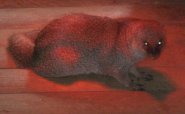 The Small Asian mongoose (Herpestes javanicus) can be found (either native or introduced) in so many places on earth,: Afghanistan, Bangladesh, Bhutan, Cambodia, China, India, Indonesia, Malaysia, Myanmar, Nepal, Pakistan, Thailand and Viet Nam. They have also been introduced to the following nations/states: Cuba, Dominican Republic, Fiji, Jamaica, Japan, Puerto Rico, Suriname and Hawaii. Why are they introduced so extensively, you may ask, well...one reason is to minimize the populations of both snakes and rodents in sugarcane fields. The mongoose introduction did not have the desired effect of rat control.
The Small Asian mongoose (Herpestes javanicus) can be found (either native or introduced) in so many places on earth,: Afghanistan, Bangladesh, Bhutan, Cambodia, China, India, Indonesia, Malaysia, Myanmar, Nepal, Pakistan, Thailand and Viet Nam. They have also been introduced to the following nations/states: Cuba, Dominican Republic, Fiji, Jamaica, Japan, Puerto Rico, Suriname and Hawaii. Why are they introduced so extensively, you may ask, well...one reason is to minimize the populations of both snakes and rodents in sugarcane fields. The mongoose introduction did not have the desired effect of rat control.A Small Indian Mongoose has thick fur, and the undersides are lighter in color. Male Small Indian Mongooses are bigger than the opposite sex, but just by a bit. Diet of this mongoose encompasses as many kinds as the number of countries mentioned above, their diet is mainly insectivorous, but also consists of fish, fruits, rodents, reptiles, birds' eggs, snakes, frogs, slugs, snails, spiders, insects.
They are famous for killing snake. How do they kill snakes? Are they immune from the poison/venom? Answer is no, they are definitely not immune, but the mongooses strikes so fast that the snake has no time to bite. To kill a snake, it would lash out by successive bites until it could manage a lock behind the head, then it would hold the snake with the paws.
These mongooses are completely diurnal, living in burrows. Breeding season for the females happens two to three times a year.
Picture of the Small Asian Mongoose by Liné1, licensed under GFDL
The Javan mongoose, small asian mongoose is listed as Least Concern (LR/lc), lowest risk. Does not qualify for a more at risk category. Widespread and abundant taxa are included in this category, on the IUCN Red List of Threatened Species
Countries
Afghanistan, Bhutan, Burma, Cambodia, China, India, Indonesia, Malaysia, Nepal, Pakistan, Thailand and VietnamSome facts about the
Javan mongoose
Adult weight : 0.8 kg (1.76 lbs)
Maximum longevity : 17 years
Female maturity :301 days
Male maturity : 122 days
Gestation : 49 days
Weaning : 50 days
Litter size : 2
Interval between litters : 151 days
Weight at birth : 0.026 kg (0.0572 lbs)
Weight at weaning : 0.275 kg (0.605 lbs)
Basal metabolic rate : 2 W
Body mass : 0.611 kg (1.3442 lbs)
Temperature : 39.85 °C (103.73 °F)

Custom Search